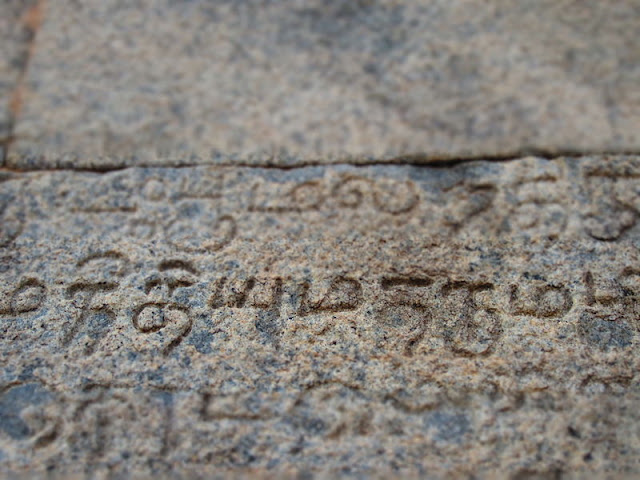Erumbeeswarar Temple, Thiruverumbur – The Temple
Erumbeeswarar
Temple is located atop a 60 feet (18 m) hill with a flight of granite
steps to the top. Since the temple is atop a hill, it is locally called
"Malai Kovil" (meaning hill temple). The temple complex has two prakarams (outer courtyard)
and a two – tiered Rajagopuram (gateway tower). The central shrine
faces east and holds the image of Erumbeeswarar (Shiva) in the form
of lingam made of mud mound with ups and downs without a perfect
shape. It is a sand Linga, hence no abishek is performed. Only oil application
is followed.
As there
is a gap in between, it appears as if there are two Lingas. It is said that the
right side is of Shiva part and the left as Shakti part, hence praised as
‘Shivasakthi Linga’. As ants (Erumbu in Tamil) are consuming the
nivedhana objects in the sanctum, it is believed that Shiva himself is
acknowledging the nivedhana offers during the Pujas. This darshan is
considered very important by the devotees. Of the two Dwarapalakas in the
Lord’s shrine, one looks angry and the other smiling.
People
generally known for their temperate qualities, become softer after worshipping
the Lord, it is believed. The granite images Ganesha (son of Shiva and god of wisdom), Murugan (son of Shiva and god of war), Nandi (the bull and
vehicle of Shiva) and Navagraha (nine planetary deities) are located in the hall
leading to the sanctum. As in other Shiva temples of Tamilnadu, the first
precinct or the walls around the sanctum of Erumbeeswarar has images of Dakshinamurthy (god of knowledge), Durga (warrior-goddess)
and Chandikeswarar (a saint and devotee of Shiva).
The
central image of Erumbeeswarar is made of mud mound and is referred by other
names like Erumbeesar, Mathuvaneswarar, Manikoodalachapathi, Piplikesvarar and
Manickanathar. The inscriptions in the temple refer Erumbeeswarar as Thirumalai
Alwar, Thiruverumbur Alwar and Thiruverumburudaya Nayanar. The shrine of the
consort – goddess Narunguzhal Nayagi Amman, facing south, is located in the
second precinct of the temple. The second precinct is surrounded by granite
walls.
Narunguzhal
Nayagi Amman is referred by other names like Sugantha Kuzhalal, Soundra Nayagi,
Madhuvaneswari and Rathnambal. Different Alankarams are followed for the mother
each day. Just before Mother Narunguzhal Nayaki there is an idol of a
Mother worshipped in olden days. The path around the foothills, called
Girivalam Path, is 20 ft (6.1 m) wide and 900 m (3,000 ft)
long. The construction and beautification of the path was carried out by the
Tourism department of the government of Tamilnadu in 2011.
The
temple has a garden maintained by Bharat Heavy Electricals Limited (BHEL,
Trichy). Sun God in the Navagraha shrine is with his two consorts Usha and
Pradyusha both facing each other. Lord Kailasanatha graces from a
separate temple left of this temple. The temple has four theerthas –
Brahmma Theertham, Madhu Theertham, Kumara Theertham and Padma
theertham. It is said that the hill of this place is but a piece of the
Meru mount split by Vayu – God of Wind when a competition arose between him &
the divine serpent Adisesha to decide the power of their physical strength.
There is
Lord Shanmugha Subramnaya’s shrine with his consorts Valli and Deivanai between
the 2 Kasiviswanathar shrines behind the sanctum sanctorum. There is the
Shatkona Chakra below his Peeta. Worshipping Lord Shanmugha Subramanya
along with this Chakra brings immense benefits to the devotee, it is
said. Selva Vinayaka graces the devotees in the temple.
Swarnakala
Bhairava shrine is in the prakara-corridor with a furious look. Mother
Gajalakshmi is opposite to Bhairava in a separate shrine. Worshipping both
simultaneously relieves the devotee from fears and ensures prosperity in
family. The one special feature in the temple is Lord Sankara Narayana
combining the greatness of both Lord Shiva and Lord Vishnu and Lord Nataraja
with anklets behind the presiding Lord Shiva goshta wall.
Lord
Shiva’s vehicle, the Nandi sits calmly under his own mandapam that is open to
view on all four sides. Sthala Vriksham is Vilva Tree (Aegle marmelos). There
is a shrine for a slightly bigger idol of Ganesha at the foothill. The holy
tank is also found opposite to the temple entrance. On top of the hill, one can
get an aerial view of the entire village, the river Cauvery and the holy tank.



































































































